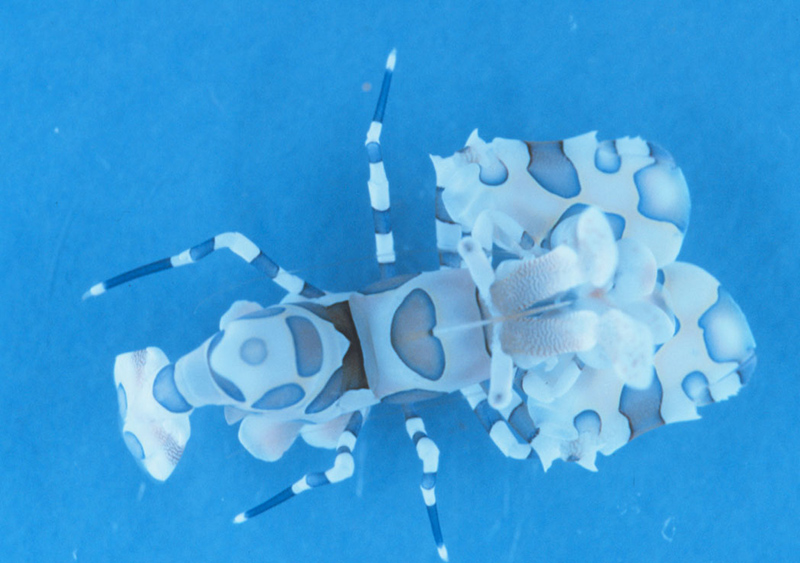
Given the variation in size, form, and habitats of shrimp species, it shouldn't be too surprising that there is considerable diversity in the way that males and females find each other, court and mate. The suite of ecological, morphological, and behavioral adaptations which have co-evolved to assure successful mating are known as mating "strategies" by evolutionary biologists.
One strategy, monogamy, is simply for an adult male and female to remain together during an entire breeding season or perhaps during their entire lifetime. When the prespawning female approaches a mating molt, the male is right there, ready to mate. Neither sex has to expose themselves to predation by searching for a mate. They can stay protected in their burrow or shelter except to search for food or other needs. A shelter may be a burrow they construct or on or within a host in symbiotic species. However, the male and female have to get along, and male and females of monogamous pairs are usually about the same size, which cuts down on "quarelling" (i.e., aggressive behavior towards each other. However, such male-female pairs may be socially but not sexually monogamous, i.e. live together and usually mate with each other but males (especially) may wander out and mate with solitary females.Many alpheids and symbiotic palaemonoids are monogamous.
 |
|
| Alpheus angulosus, a species that lives in socially monogamous male-female pairs; partners are usually similar in size | Hymenocera picta , a predator of starfishes, lives in monogamous pairs; in this species , males are somewhat smaller than females (Wickler, W. and U. Seibt. 1981. Monogamy in Crustacea and Man. Zeitschrift für Tierpsychologie 57: 215-234.) |
In some shrimp species, males are as bigger than females and have proprotionately larger claws (aggressive weapons), e.g. Betaeus longidactylus (photos below). They find females approaching spawning before they undergo a premating molt (when mating takes place in most shrimps, except for some penaeoids) and defend them from other males, thus insuring that they will inseminate the female. After mating, the male usually leaves and begins searching for another This is known as a “temporary mate guarding” or "search and attend" strategy.
 |
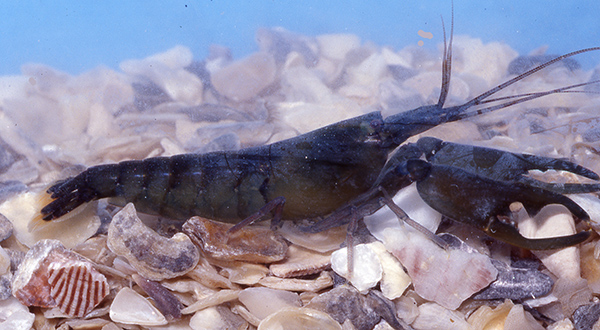 |
Female Betaeus longidactylus (Alpheidae) from southern California tidepools. Note the major claws (chelipeds) are equal in size and proportionately smaller in size than males. |
Betaeus longidactylus male, with enlarged chelipeds (weaponry). |
In some species with very large dominant males with massive “weaponry” (large claws and/or third maxillipeds), such as some Macrobrachium, Rhynchocinetes,probably Cinetorhynchus (see below) and Saron species, it is the females that seek out the dominant males, a system termed “neighborhoods of dominance” by Martin Thiel and colleagues. In this mating system, prespawning females find dominant males by the soluble metabolites (distance sex pheromones) males give off in their urine (Diaz, E.R. and M. Thiel. 2004.Chemical and visual communication during mate searching in rock shrimp. Biol. Bull. 206: 134-143).
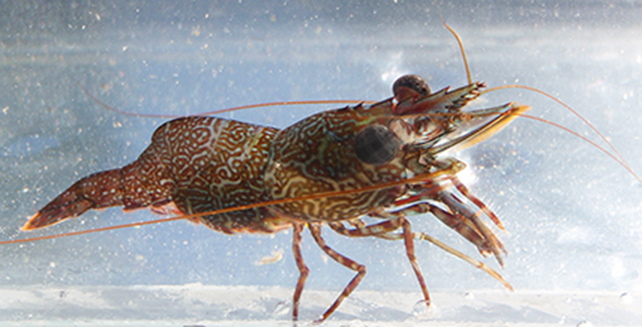 |
 |
| Female Cinetorhynchus hendersoni from Hawaii; note much smaller major chelipeds compared to male (right) (Bauer, Okuno and Thiel, 2014; photo by Martin Thiel) | Dominant male, Cinetorhynchus hendersoni from Hawaii; note much enlarged, wrench-like major chelipeds (Bauer, Okuno and Thiel, 2014; photo by Martin Thiel) |
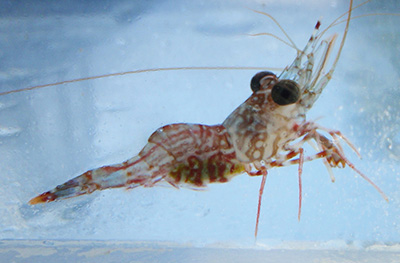 |
|
| Female Cinetorhynchus n.sp. from Hawaii; (Bauer, Okuno and Thiel, 2014; photo by Martin Thiel) | Dominant male, Cinetorhynchus n.sp. from Hawaii; (Bauer, Okuno and Thiel, 2014; photo by Martin Thiel) |
However, in many other species, males are smaller or at least similar in size as the females and their weaponry (chelae and/or third maxillipeds) is also similar. The adaptive advantage of smaller males is that they can hide more easily from predators and devote more energy to searching for females. In females of such species, selection has been for larger females as they can produce more eggs than small ones. Contact between male and female is somewhat at random. When not feeding or grooming, males are usually searching for or prespawning females that have just molted. This type of species usually occur at higher densities or aggregations so that encounters with intraspecifics are frequent. Males recognize prespawning, recently molted (receptive) females by physical contact, usually with the long chemotactile flagella of the antennae. Males are responding to a contact pheromone, i.e., a substance on the surface of the recently molted female which stimulates the male to seize and mate with the female, after which he abandons her and goes about his normal feeding and mate search activities. This type of mating system is known as “pure search” or simply a “promiscuous” mating system.
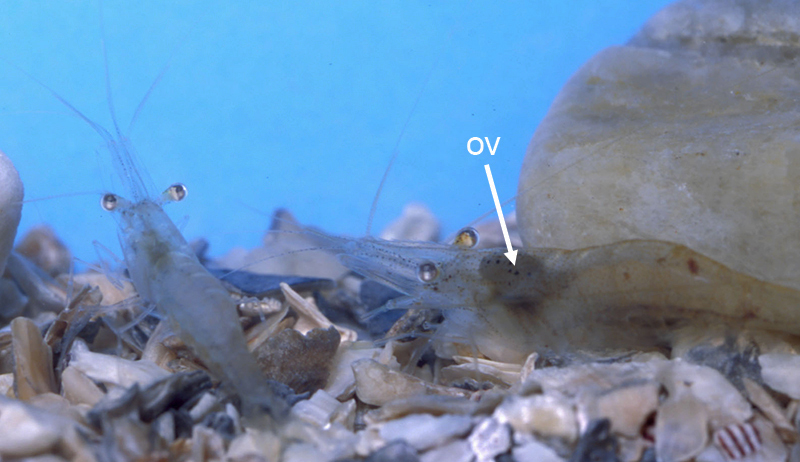 |
| Example of a small male (left), large female (right) species (Palaemonetes pugio) with a pure searching (promiscuous) mating system |
In two such species studied, Sicyonia dorsalis (a penaeoid) and Palaemonetes pugio (a caridean), time-lapse video observations showed that males do not recognize nor guard females that are approaching a molt and be ready to mate. Rather, their strategy is simply to be socially active, increasing the chances of encountering a just-molted, sexually receptive female. When one is encountered, recognition and mating occurs within seconds or a few minutes, and the mating partners separate quickly (see Bauer, 1996a for S. dorsalis , Bauer & Abdalla, 2000 for P. pugio ). Although the male is not assured of a mating, as are males of species which guard premolt females, he does not have to invest a lot of energy in growth or defense of the female, and exposure to predators is reduced. In P. pugio , it appears that a pheromone is released about an hour before her mating molt, stimulating nearby males to a more active search pattern (Bauer & Abdalla, 2000). Release of an attractant by the female in P. pugio and others (e.g., Macrobrachium rosenbergii) appears to be inadvertent and unavoidable. The short period of premating attractiveness avoids harassment of the female which can result her injury or even death.
Mating behavior pure-search species is usually brief with little or no precopulatory courtship. In Palaemonetes pugio and Heptacarpus sitchensis (Thoridae), once a male has touched a recently molted, prespawning female with his antennae or legs, he will seize her, crawl above her, and dip down below her so their genitalia make contact, whereupon the male adheres spermatophores to her.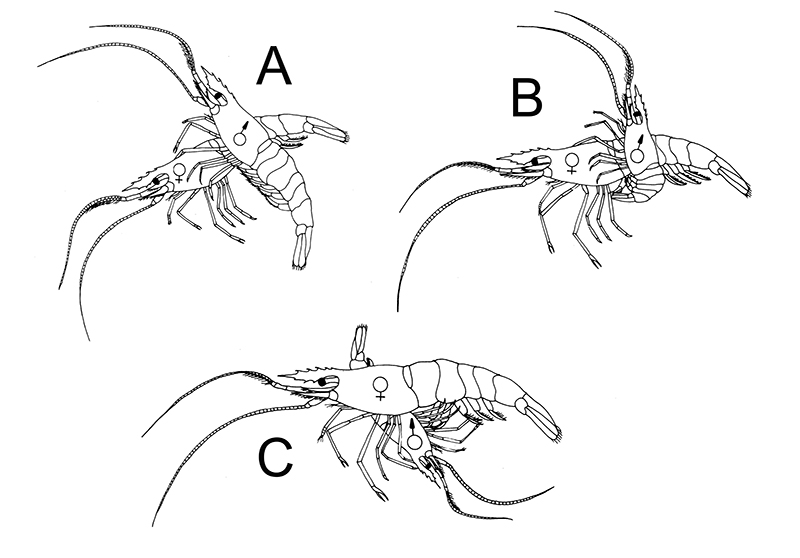 |
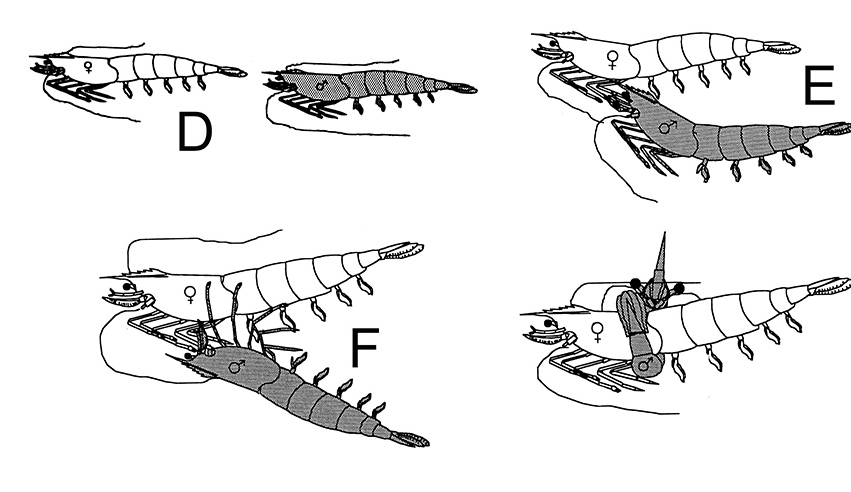 |
| Mating and copulation in Palaemonetes pugio (Berg, A.B. and P.A. Sandifer. 1984. Mating behavior of the grass shrimp Palaemonetes pugio Holthuis (Decapod: Caridea). J. Crust. Biol. 4: 417-424.) | Precopulatory courtship swimming (A-B) and copulation (C-D) in Litopenaeus (Penaeus) vannamei (from Misamore, M.J. and C. L. Browdy. 1996. Mating behavior in the white shrimps Penaeus setiferus and P. vannamei : a generalized model for mating in Penaeus. Journal of Crustacean Biology 16: 61-70.) |
Penaeid mating may be preceded by a brief courtship in which the male recognizes a receptive female, swims in tandem below her while touching her underside with his antennae and rostrum (Litopenaeus) or, in bottom-dwelling Sicyonia species, crawls behind the female, lifting up and touching the female underside, after which he seizes and dips below her, depositing his spermatophores.
It may appear that the female has little choice in the mating and insemination process, but actually she does. She can just flee from the male, or when he is below her in the copulatory position, cover her genitalia with the her anterior swimeretes or otherwise block successful spermatophore transfer. Mating experiments with marked males showed that a male or more males may copulate with a female but fail to or only partially inseminate a female (Bauer, 1992b).
 |
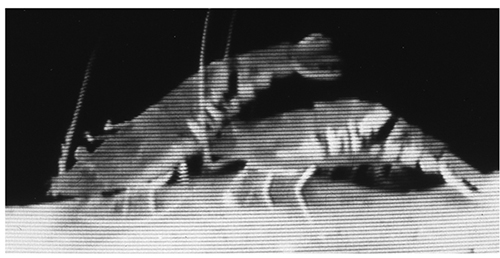 |
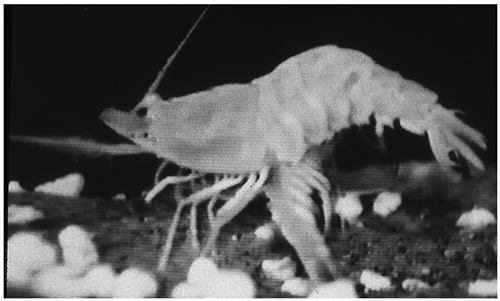 |
| Male (right) following a recently molted receptive female | Male (right) pushing the female's abdoment upwards in order to be able to dip down below here to copulate | Male below, copulating and inseminating the female. In this position, the male and femalegenitalia are in contact |
In order to understand mating systems, one must understand the basic breeding biology of the species. This work is as interesting and rewarding. Observations and experiments on mating systems have revealed the relationship between mating, molting, spawning, mechanics of actual mating, and sex attractants (pheromones) in various species (see Bauer 1996a,b, 1992a, 1991a,b, 1986, 1979a, 1976; Bauer & Cash, 1991; Bauer & Min, 1993, Bauer & Holt, 1998). Research is needed on these topics, especially on pheromones.
Back to Home Page.